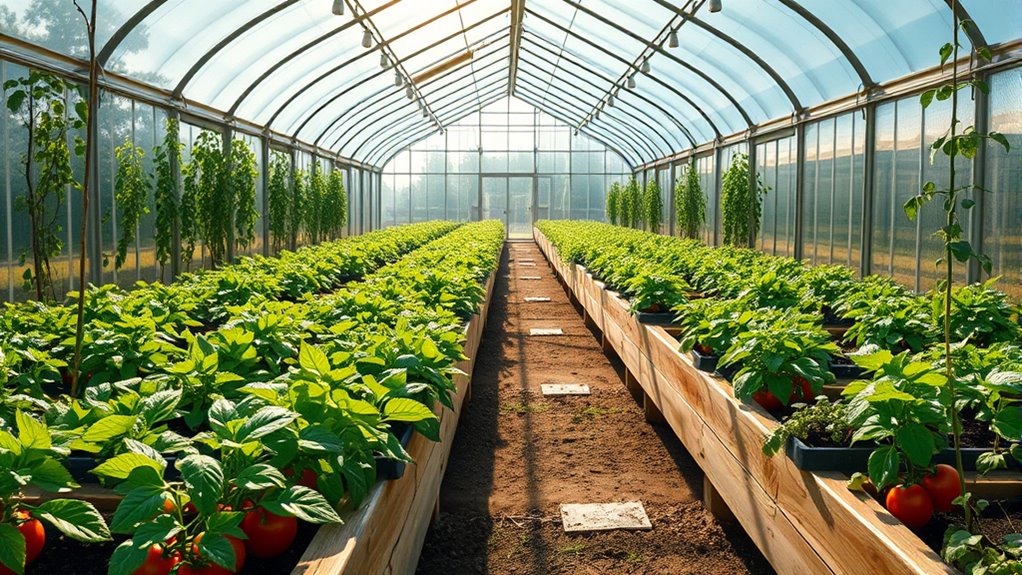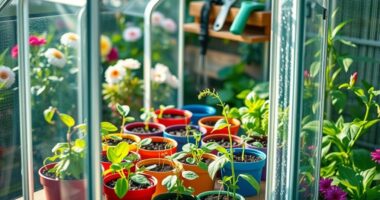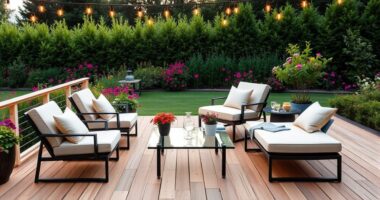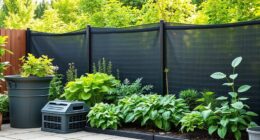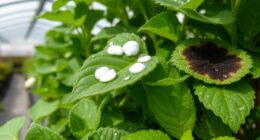When I think about the best vegetable greenhouse designs, I know the right structure can maximize my gardening potential. For instance, the Year-Round Solar Greenhouse offers net-zero energy solutions, while Effortless Greenhouse Gardening is superb for newcomers. If I'm into DIY, I can explore plans in How to Build Your Own Greenhouse. Choosing the best design is key to a thriving garden, and the details matter. There's so much more to discover about optimizing my greenhouse!
Key Takeaways
- Choose designs that optimize sunlight, ventilation, and climate control for diverse vegetable crops, enhancing growth potential year-round.
- Utilize hoop houses or cold frames for low-cost, effective structures that can extend growing seasons and facilitate early planting.
- Consider larger greenhouse setups for maximizing space, allowing for a wider variety of vegetables and crop rotation strategies.
- Implement energy-efficient designs to minimize heating and cooling costs while promoting sustainable practices in your gardening.
- Select materials like polycarbonate for durability and heat retention, ensuring optimal conditions for vegetable growth throughout different seasons.
The Year-Round Solar Greenhouse: Design and Build a Net-Zero Energy Greenhouse
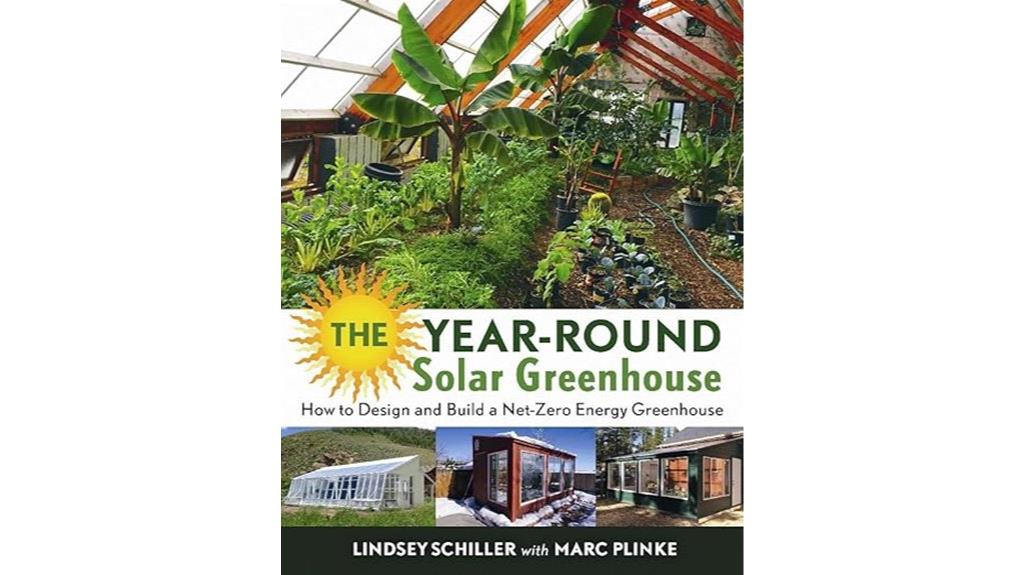
If you're someone who's enthusiastic to extend your growing season or even cultivate vegetables year-round, then "The Year-Round Solar Greenhouse" is an excellent choice for you. This book delivers clear, engaging insights into designing and building a net-zero energy greenhouse. I found its wide range of construction techniques inspiring, especially the innovative GAHT system for efficient heating. While it may not provide step-by-step instructions for beginners, it certainly equips handy readers with the knowledge needed to get started. Overall, this resource is a fantastic investment for anyone looking to revolutionize their gardening experience and boost their confidence in greenhouse building.
Best For: Gardeners and DIY enthusiasts looking to extend their growing seasons or grow vegetables year-round with innovative greenhouse designs.
Pros:
- Engaging and clear writing style makes the content accessible and enjoyable to read.
- Comprehensive coverage of various greenhouse building techniques and innovative concepts like the GAHT system.
- Provides recommendations for further reading, enhancing the educational value for readers.
Cons:
- May lack detailed guidance on specific construction techniques, which could be challenging for complete beginners.
- Some readers might find the information too broad and need supplementary resources for practical implementation.
- Assumes a certain level of handyman skills, which may not suit all readers.
Effortless Greenhouse Gardening for Beginners
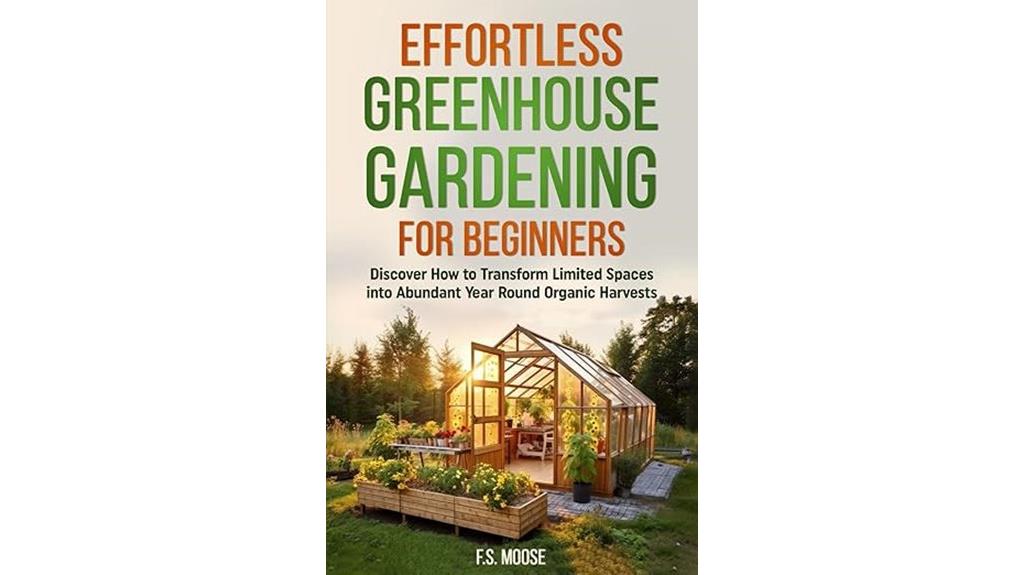
For anyone enthusiastic to plunge into greenhouse gardening without feeling overwhelmed, "Effortless Greenhouse Gardening for Beginners" is the perfect choice. This guide simplifies the entire process, from planning and building your greenhouse to maintaining it for year-round harvests. With clear sections and practical tips, I found it easy to select plants and manage pests effectively. The engaging format kept me inspired, even with my busy schedule. Plus, it's helped me adapt to climate challenges while maximizing my yields. If you're starting out, this book will prepare you for a successful and satisfying gardening journey.
Best For: This book is best for beginners and novices looking to start greenhouse gardening with practical guidance and straightforward techniques.
Pros:
- Provides step-by-step instructions that simplify the gardening process.
- Includes practical tips on plant selection, pest management, and maximizing yields.
- Engaging format and clear sections make it accessible for busy individuals.
Cons:
- May not cover advanced gardening techniques in great detail for seasoned gardeners.
- Limited focus on specific plant varieties may not satisfy all gardening preferences.
- Some readers might find the content too basic if they have prior gardening experience.
How to Build Your Own Greenhouse: Designs and Plans
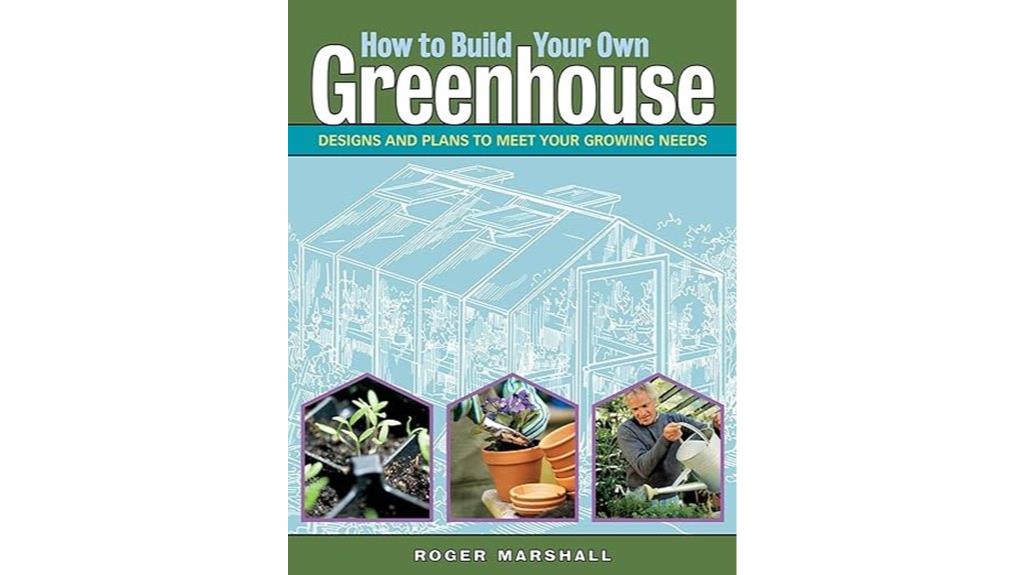
Building your own greenhouse can be an exciting venture, especially if you're a DIY enthusiast looking for professional-quality results. I found an extensive guide that covers essential design considerations, materials, and structures tailored to different climates. It's perfect for anyone, whether you're a novice or experienced builder. The book's clear concepts and visuals helped me communicate ideas effectively to contractors. While it lacks in-depth aquaponics info, it's still a fantastic resource for standard projects. I highly recommend it if you're serious about greenhouse ownership, providing practical advice for effective planning and construction. Happy building!
Best For: DIY greenhouse builders looking for professional-quality results and comprehensive guidance on construction.
Pros:
- Extensive design considerations for various materials and climate conditions, suitable for both novice and experienced builders.
- Clear concepts and visuals that aid in effectively communicating ideas to architects or contractors.
- Highly recommended for serious greenhouse enthusiasts, offering practical advice for effective planning and construction.
Cons:
- May overwhelm those seeking only basic structures, as it covers a wide range of details and complexities.
- Limited information on specialized topics like aquaponics, requiring additional resources for those interested in that area.
- While more informative than cheaper alternatives, it may be considered too detailed for casual builders looking for quick solutions.
DREAM GREENHOUSE FOR BEGINNERS: ULTIMATE COURSE TO GROW HEALTHY PLANTS
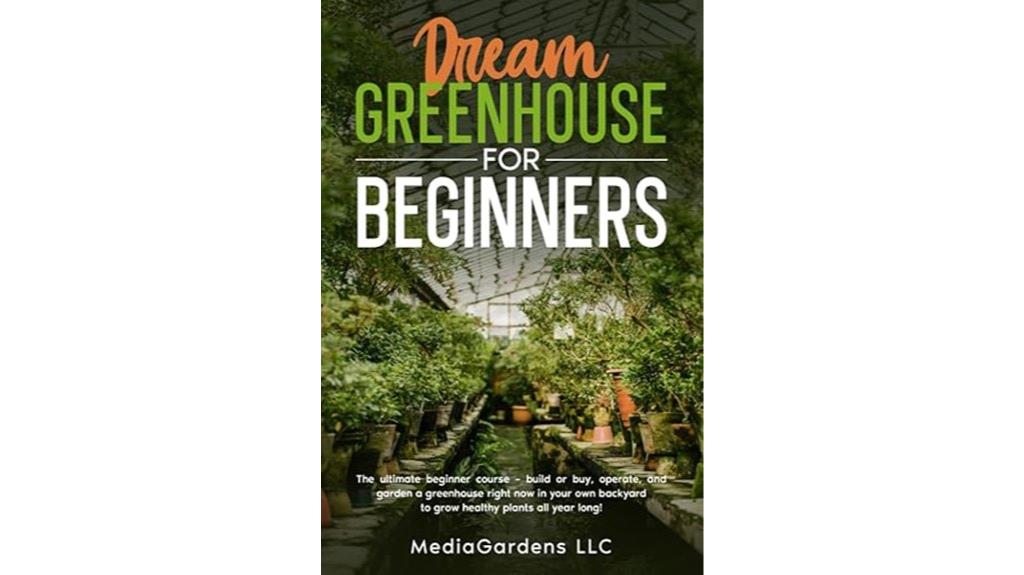
Anyone looking to immerse themselves in the world of greenhouse gardening will find "DREAM GREENHOUSE FOR BEGINNERS" an invaluable resource. This thorough guide made the process of building or buying a greenhouse so much easier for me. With step-by-step instructions on construction, climate control, and irrigation, I felt equipped to create a thriving environment for my plants. The practical tips on maintenance and care, including soil pH and ventilation, helped me maximize my greenhouse's potential. Plus, the insights on different greenhouse types guaranteed I made the right choice for my space. I can't recommend it enough for aspiring gardeners!
Best For: Beginners interested in greenhouse gardening who want a comprehensive guide to building or buying a greenhouse.
Pros:
- Step-by-step instructions make the construction and setup process manageable for novices.
- Practical tips on maintenance and care help maximize plant growth and greenhouse potential.
- Insights on various greenhouse types assist readers in selecting the best option for their specific climate and space.
Cons:
- Some readers may find the lack of detailed references on nutrients limiting.
- A few may desire more in-depth information on specific gardening techniques.
- The book may not address advanced gardening topics, which could be a drawback for seasoned gardeners.
Greenhouse Gardening for Beginners: The Definitive Guide
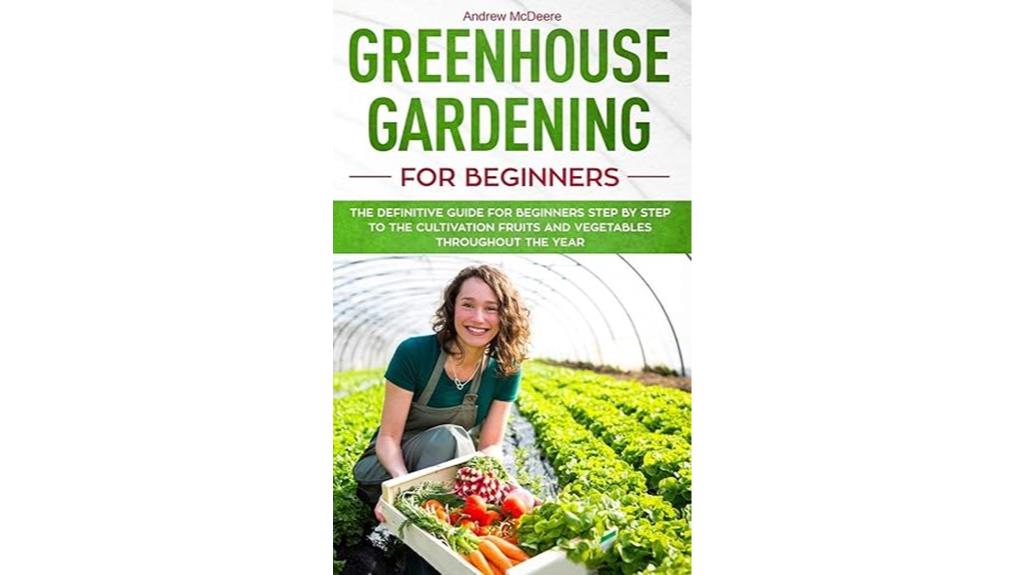
If you're a beginner enthusiastic to get started with greenhouse gardening, "Greenhouse Gardening for Beginners: The Definitive Guide" is tailored just for you. This book offers step-by-step instructions for growing fruits, vegetables, flowers, and herbs year-round. It's particularly useful if you're in the Southeast U.S. and want to cultivate larger crops. However, be aware of its editing issues, which can make navigation tricky. While some find it helpful, others wish for more depth in planting advice. Still, if you're ready to embark on this journey, this guide can provide a solid foundation for your gardening journey. Happy gardening!
Best For: Beginners interested in greenhouse gardening, particularly those in the Southeast U.S. looking to grow larger crops.
Pros:
- Provides step-by-step instructions for year-round gardening of fruits, vegetables, flowers, and herbs.
- Offers useful guidance for purchasing and setting up a greenhouse.
- Many readers report positive delivery experiences and timely arrival of the book.
Cons:
- Contains significant editing issues, such as spelling errors and poor formatting, which affect usability.
- Lacks depth and practical planting advice, focusing excessively on greenhouse mechanics.
- May not be suitable for smaller backyard growers, particularly in regions like the Northwest.
Greenhouse Gardening: A Beginner's Guide to Growing Fruits and Vegetables
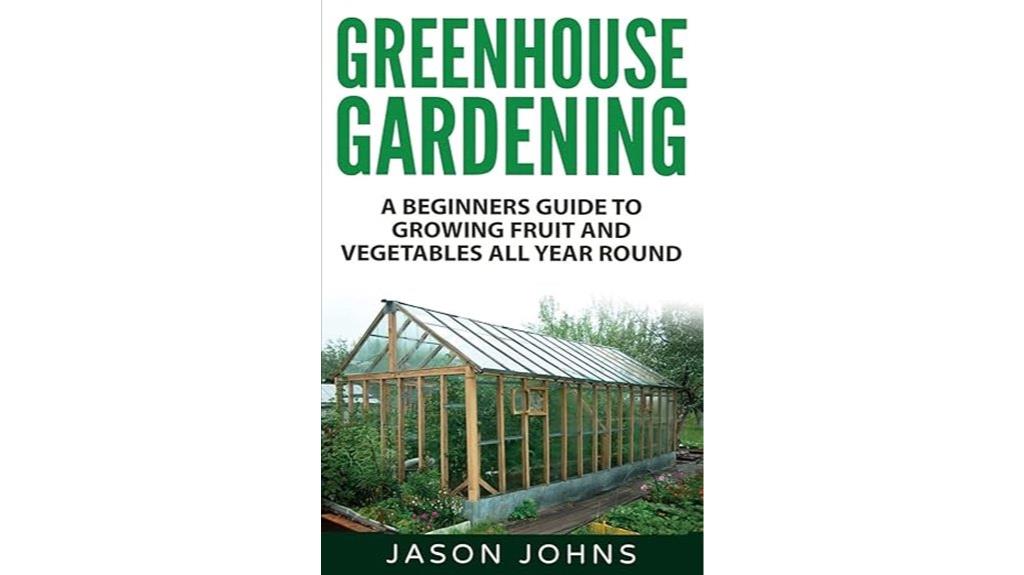
For aspiring gardeners enthusiastic to cultivate fresh produce year-round, "Greenhouse Gardening: A Beginner's Guide to Growing Fruits and Vegetables" by Jason Johns stands out as an invaluable resource. This guide walks you through selecting the right greenhouse and ensuring a solid foundation. It covers essential aspects like irrigation, ventilation, and heating to create the perfect environment for your plants. You'll discover techniques to extend your growing season and successfully grow a variety of fruits and vegetables. With practical tips on managing pests and maintaining conditions, this book empowers you to transform your greenhouse into a thriving oasis of fresh produce.
Best For: Beginners looking to set up and successfully manage a greenhouse for year-round gardening.
Pros:
- Provides step-by-step guidance on selecting and building a greenhouse.
- Offers practical tips for growing a variety of fruits and vegetables, including pest management.
- Includes valuable insights on irrigation, ventilation, and heating to maintain optimal plant conditions.
Cons:
- May be too basic for advanced gardeners seeking in-depth techniques.
- Leans towards larger greenhouse setups, which may not suit those with smaller spaces.
- Some readers may find the visual elements insufficient for complex gardening tasks.
Greenhouse Gardening for Beginners
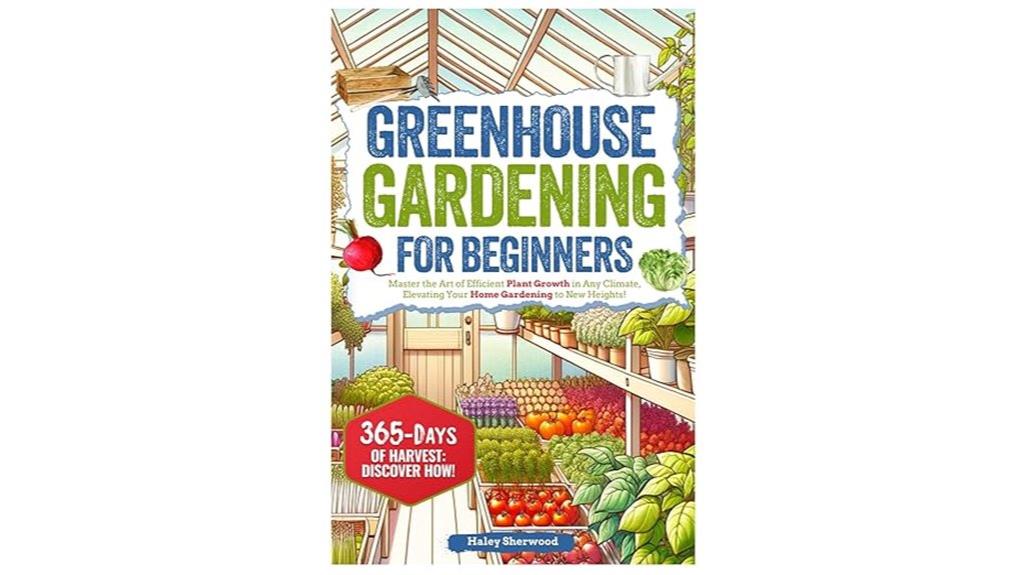
Aspiring gardeners looking to cultivate their own vegetables year-round will find *Vegetable Greenhouse Designs* an invaluable resource. In my experience, *Greenhouse Gardening for Beginners* by Haley Sherwood is perfect for those just starting. It breaks down complex topics like selecting the right greenhouse and managing temperature, making them easy to grasp. I appreciate the practical tips on climate control and planting schedules, which helped me set up my own greenhouse successfully. Despite some critiques of the writing style, the book's valuable insights make it a must-read for anyone enthusiastic to plunge into greenhouse gardening. Trust me, you won't regret it!
Best For: Beginners eager to learn about greenhouse gardening and those looking to refine their gardening skills.
Pros:
- Provides step-by-step instructions on selecting greenhouses and managing climate conditions.
- Includes practical tips for planting schedules and sustainable gardening practices.
- Simplifies complex gardening topics, making them accessible for novice gardeners.
Cons:
- Some readers may find the author's poetic writing style less appealing.
- A few critiques mention a preference for more straightforward, practical guidance.
- Not all readers may resonate with the flowery language used throughout the book.
Black & Decker Complete Guide to DIY Greenhouses
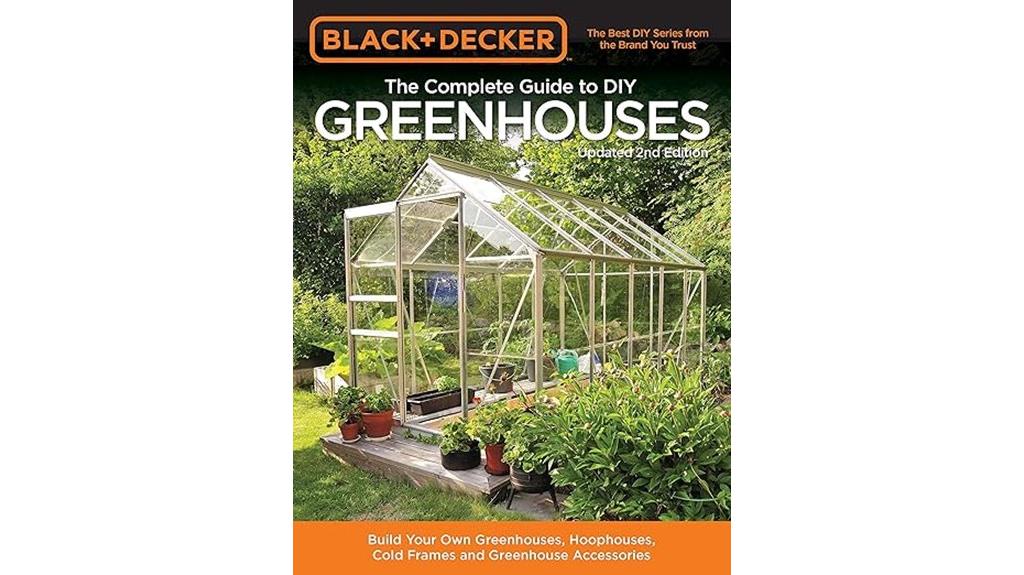
The "Black & Decker Complete Guide to DIY Greenhouses" is perfect for anyone enthusiastic to immerse themselves in greenhouse construction, especially beginners who may feel overwhelmed by the variety of options available. This thorough guide offers detailed construction plans for various structures, including hoophouses and cold frames, with clear dimensions and material suggestions. I found the color photography and practical advice invaluable, helping me visualize my projects. While some measurements needed adjustment, the overall clarity and organization made it easy to follow. Whether you're just starting or looking to enhance your gardening skills, this book is a fantastic resource.
Best For: This book is best for DIY enthusiasts and beginner gardeners looking to build their own greenhouses with detailed guidance and practical advice.
Pros:
- Extensive color photography that helps visualize projects.
- Clear construction plans with specific dimensions and material suggestions.
- User-friendly organization and layout, making it easy to navigate.
Cons:
- Some measurements may require adjustments during construction.
- May feel overwhelming for complete beginners without prior experience.
- Focuses primarily on construction, potentially lacking in advanced gardening techniques.
Greenhouse Gardening for Beginners: A Complete Guide to Growing in Your Greenhouse

Creating a thriving greenhouse can transform your gardening experience, especially if you're a beginner keen to grow year-round. "Vegetable Greenhouse Designs" is perfect for anyone looking to cultivate vegetables, fruits, and herbs in a controlled environment. I found "Greenhouse Gardening for Beginners" by Fern Ashby to be an invaluable resource. It guides you through choosing the right greenhouse and implementing sustainable practices. The clear instructions and practical tips made me feel confident about my gardening journey. I even gifted a copy to a friend! With this guide, you'll turn your greenhouse into a flourishing oasis in no time.
Best For: Beginners and those looking to enhance their gardening skills in a greenhouse environment.
Pros:
- Offers clear instructions and practical tips, making it easy for beginners to follow.
- Covers a wide range of topics, from choosing the right greenhouse to sustainable gardening techniques.
- Inspires confidence in new gardeners, encouraging them to embark on their gardening journey.
Cons:
- May not provide advanced techniques for seasoned gardeners seeking in-depth knowledge.
- Some readers might find certain sections too basic if they have prior gardening experience.
- Limited focus on specific plant varieties may not satisfy all gardening enthusiasts.
GADI Raised Garden Bed Kit for Vegetables and Flowers
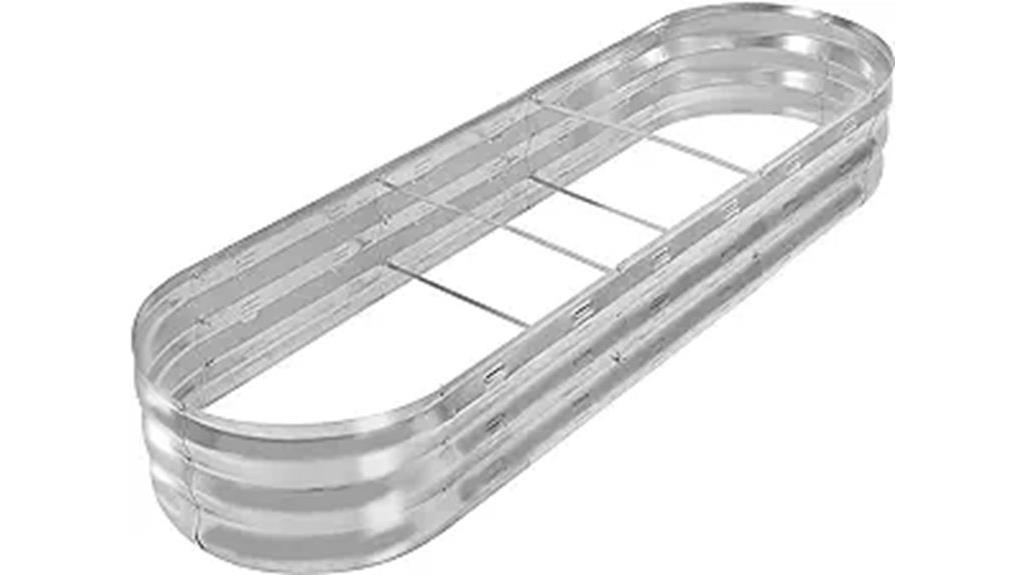
For anyone looking to elevate their gardening experience, the GADI Raised Garden Bed Kit stands out with its modern galvanized metal design, perfect for growing vegetables, flowers, and herbs. Measuring 20D x 67W x 10H, this stylish oval planter box boasts a capacity of 7 cubic inches. Its durable steel construction features a double layer of anti-corrosion paint, ensuring long-lasting use. I love the open bottom design, which prevents water buildup and promotes healthy root growth. Assembly is a breeze, making it an ideal choice for any gardener wanting a versatile and efficient gardening solution.
Best For: Gardeners and plant enthusiasts looking for a durable, stylish, and easy-to-assemble raised garden bed for vegetables, flowers, and herbs.
Pros:
- Easy assembly with included hardware and instruction manual.
- Durable galvanized steel construction with rust resistance.
- Open bottom design promotes healthy root growth and drainage.
Cons:
- Limited height may not be suitable for larger plants.
- Galvanized metal may get hot in direct sunlight, potentially affecting plants.
- Requires occasional maintenance to ensure longevity and performance.
6×12 FT Greenhouse Kit for Outdoor
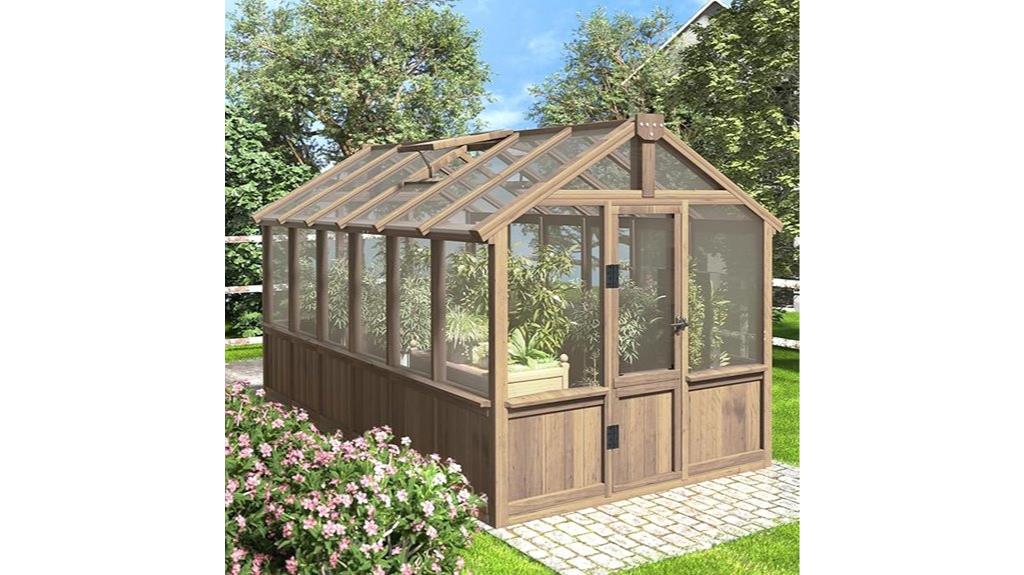
If you're looking for a spacious greenhouse that balances durability and functionality, the Yardenaler 6×12 FT Greenhouse Kit is an excellent choice. With sturdy fir wood construction and 6MM thick polycarbonate panels, it withstands various weather conditions while allowing plenty of light. The adjustable roof vent promotes air circulation, keeping your plants happy and healthy. Plus, the lockable door guarantees security. I love that it offers ample space for growing vegetables and flowers, along with a cozy area for relaxation. With a 4.8-star rating, it's clear that many gardeners, including me, appreciate its quality and ease of assembly.
Best For: Gardeners seeking a durable and functional greenhouse for growing a variety of plants and enjoying a relaxation space.
Pros:
- Sturdy construction with fir wood and polycarbonate panels ensures durability in various weather conditions.
- Adjustable roof vent enhances air circulation, promoting healthy plant growth.
- Ample space for gardening and leisure activities, making it versatile for different uses.
Cons:
- Assembly may require time and effort, as indicated by customer feedback.
- Roof vent design has received some criticism regarding airflow efficiency.
- Shipping in multiple boxes may lead to delays in receiving all parts simultaneously.
The New Garden Survival Bible: [5 in 1] Ultimate Guide to Homesteading & Greenhouse Gardening

Anyone looking to boost their self-sufficiency and connect with nature will find “The New Garden Survival Bible: [5 in 1] Ultimate Guide to Homesteading & Greenhouse Gardening” invaluable. This extensive guide covers everything from seed starting to pest management, making it perfect for both beginners and seasoned gardeners. It emphasizes the importance of growing food at home, especially during emergencies. You'll discover techniques like vertical gardening and crop preservation, ensuring your harvest lasts. With practical advice on tools and sustainable practices, this book has transformed my gardening experience, fostering independence and a deeper connection to nature.
Best For: Individuals seeking to enhance their self-sufficiency and gardening skills, regardless of their experience level.
Pros:
- Comprehensive coverage of gardening techniques suitable for beginners and advanced gardeners alike.
- Practical tips on crop management and preservation to ensure food longevity and sustainability.
- Encourages a deeper connection with nature while promoting mental health and self-reliance.
Cons:
- May be overwhelming for absolute beginners due to the extensive information provided.
- Some techniques may require additional resources or space that not all readers have access to.
- Focus on self-sufficiency may not appeal to those who prefer traditional grocery shopping methods.
Greenhouse Gardening: The Ultimate Beginner's Guide to Growing Edibles Year-round
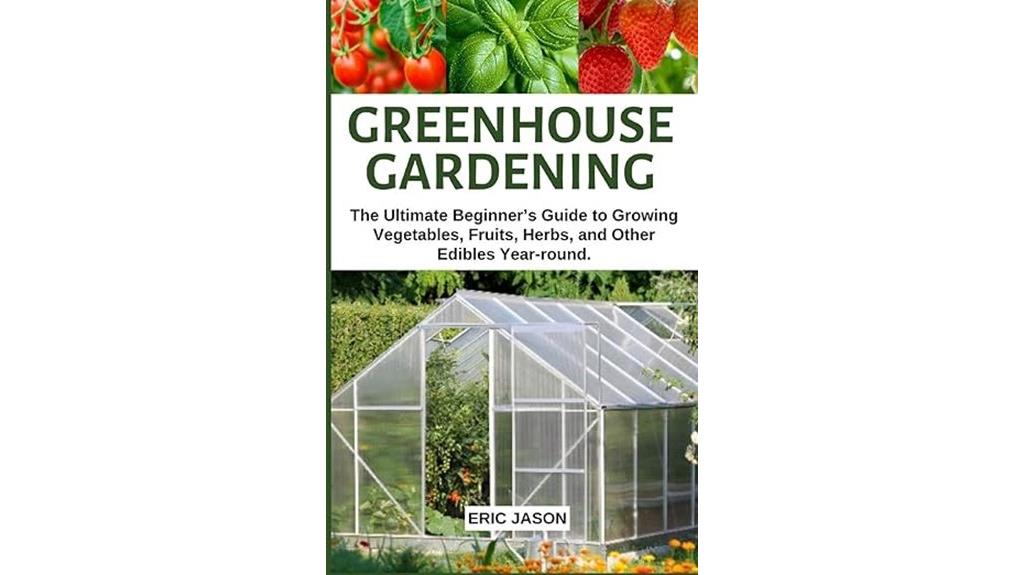
Greenhouse gardening offers a fantastic opportunity for beginners enthusiastic to grow their own edibles year-round, especially those who might feel overwhelmed by more complex gardening guides. I found the book "Greenhouse Gardening: The Ultimate Beginner's Guide to Growing Edibles Year-round" surprisingly thin, but it had some useful tips. While it lacks depth and contains grammatical errors, it's a decent starting point for novice gardeners. I wouldn't recommend it as the only resource, but it can spark your interest. Just be prepared to seek out other materials for more thorough insights into greenhouse gardening.
Best For: Beginner gardeners looking for basic information on greenhouse gardening without overwhelming details.
Pros:
- Offers useful tips for novice gardeners.
- Can serve as a starting point for those new to growing edibles.
- May spark interest in greenhouse gardening despite its simplicity.
Cons:
- Lacks depth and advanced insights for experienced gardeners.
- Contains numerous grammatical and spelling errors, affecting readability.
- Many readers feel it is not worth the price due to its brevity and simplistic content.
Hydroponics and Greenhouse Gardening: 3-in-1 Gardening Book
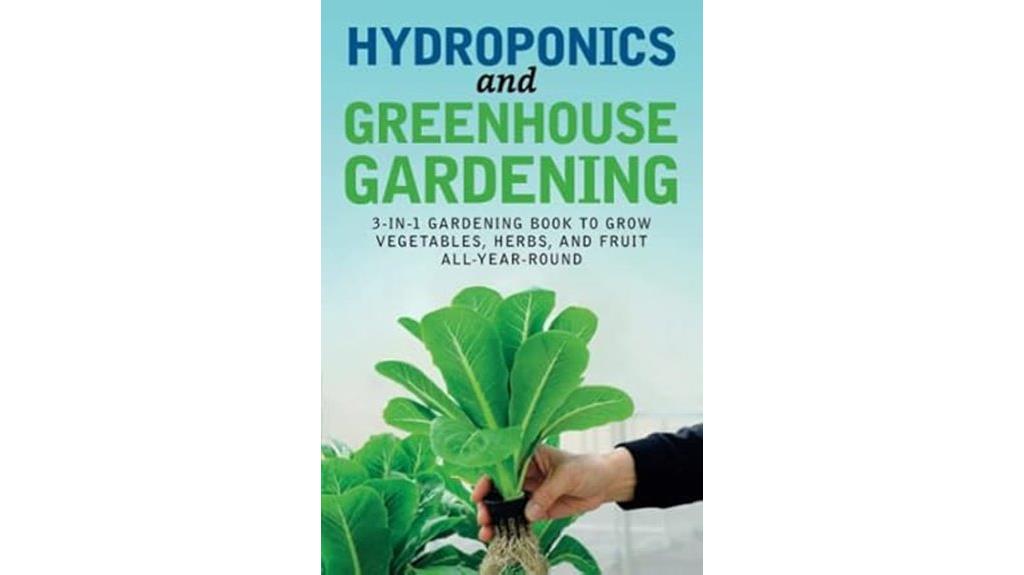
For those excited to plunge into the world of gardening, "Hydroponics and Greenhouse Gardening: 3-in-1 Gardening Book" stands out as an excellent resource. It offers clear, thorough guidance perfect for beginners like me. I've found its practical applications invaluable, especially when setting up my hydroponic systems. The detailed DIY methods help me create my own garden successfully. While I wish it had more visual aids to enhance my learning, the content is still engaging and informative. Overall, this book remains a trusted reference, and I highly recommend it to anyone keen to explore hydroponics and greenhouse gardening.
Best For: Beginners interested in hydroponics and greenhouse gardening who seek practical guidance and easy-to-understand information.
Pros:
- Comprehensive coverage of hydroponic systems and DIY gardening techniques.
- Easy-to-follow instructions that are suitable for novice gardeners.
- Positive reader feedback indicating lasting value as a reference resource.
Cons:
- Lacks advanced topics such as aquaponics for more experienced gardeners.
- Some readers desire more visual aids, like pictures and diagrams, for better understanding.
- Certain areas may lack depth, limiting the book's usefulness for in-depth study.
Factors to Consider When Choosing Vegetable Greenhouse Designs
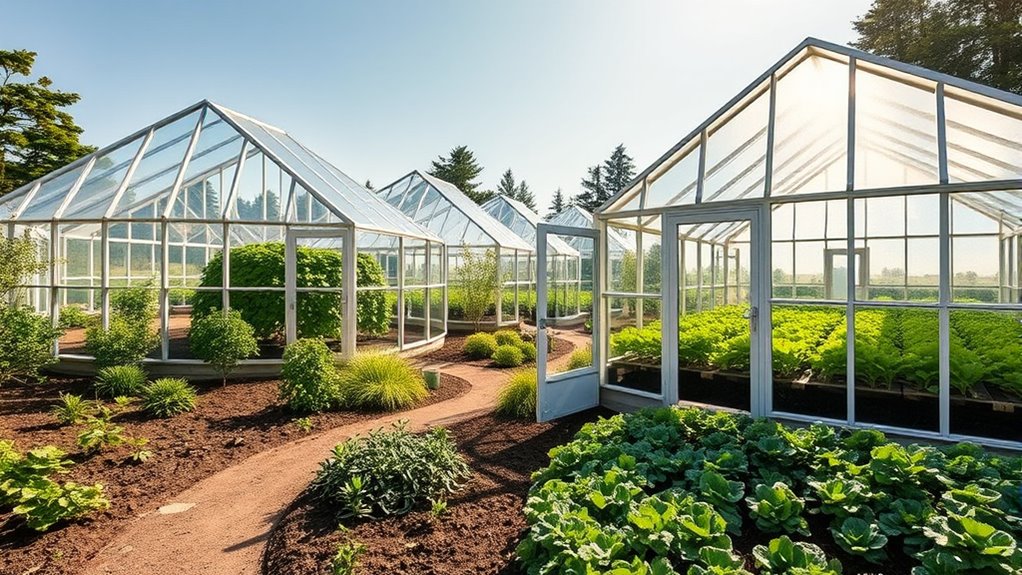
When I'm choosing a vegetable greenhouse design, I always reflect on several key factors. Climate plays a huge role in what materials and ventilation systems I might need. Plus, I have to evaluate the space I have available and how to best manage heating and cooling for ideal growth.
Climate Considerations
While selecting the right vegetable greenhouse design, I find it essential to take local climate conditions into account, as they directly affect plant growth and the greenhouse's overall efficiency. In colder climates, opting for designs with better insulation, like double-walled polycarbonate panels, can help retain heat. Conversely, in warmer areas, I prioritize ventilation features, such as adjustable roof vents and sidewalls, to keep the temperature down. I also pay close attention to the greenhouse's orientation to maximize sunlight exposure, especially in regions with limited light. Finally, considering local wind patterns is vital; I make sure my greenhouse has windbreaks or reinforced structures to withstand strong winds and prevent any potential damage.
Space Availability
Considering space availability is essential in choosing the right vegetable greenhouse design, as it directly influences both the size and functionality of the structure. I always assess the available area first, ensuring the greenhouse fits without overcrowding. A well-planned layout is key; I make sure there's easy access to plants and pathways for movement, along with space for tools. The orientation matters too—understanding sunlight exposure and wind patterns can enhance plant growth. I often opt for taller designs to utilize vertical space, allowing for additional shelving or hanging plants. Finally, I keep local zoning regulations and property boundaries in mind, as they can affect the greenhouse's size and placement. Planning well makes all the difference!
Material Selection
Choosing the right material for my vegetable greenhouse can make all the difference in its performance and longevity. I've found that glass, polycarbonate, and polyethylene each have distinct advantages. While glass offers excellent light transmission and a beautiful look, it can be pricey and needs a sturdy frame, which isn't ideal for my budget. Polycarbonate panels, on the other hand, provide great insulation and durability, making them perfect for year-round growing. They're lightweight too! If I'm looking for a more economical option, polyethylene film works well for good light diffusion, though it may need replacing more often. Finally, I can't forget about the frame material; aluminum, wood, or steel all impact the greenhouse's strength and maintenance needs.
Ventilation and Airflow
How can I guarantee my vegetable greenhouse stays healthy and productive? Proper ventilation is key. I make sure to regulate temperature and humidity to prevent heat and moisture buildup, which can stress my plants. I've found that enhancing airflow with vents, fans, and smart plant placement guarantees fresh air circulates effectively. Ideally, I aim for an air exchange rate of 0.5 to 1 air change per hour to maintain ideal conditions. I use roof vents for passive ventilation; as warm air rises, cooler air enters through side vents. For larger setups, I recommend automated ventilation systems. They adjust airflow based on temperature and humidity, refining conditions for my vegetables, and keeping them thriving throughout the growing season.
Heating and Cooling
When it comes to keeping my vegetable greenhouse thriving, effective heating and cooling systems play an essential role in maintaining the right temperatures for ideal growth. I've found that passive solar heating is incredibly beneficial; using materials that store heat during the day helps create a stable environment at night. For cooling, I make sure to incorporate roof vents or side openings to maximize airflow and prevent overheating. Additionally, I use thermal mass, like water barrels, to regulate temperature by absorbing heat during the day and releasing it when it cools down. Finally, I highly recommend investing in automated temperature control systems. They adjust heating and cooling based on real-time readings, ensuring my plants get the consistent conditions they need to thrive.
Budget and Costs
Maintaining ideal temperatures in my greenhouse has been a priority, but I also need to keep an eye on my budget. When choosing a vegetable greenhouse design, it's essential to set a budget that covers materials, construction, and ongoing maintenance costs. The initial investment can range from a few hundred to several thousand dollars, influenced by the materials—plastic, glass, or polycarbonate—and whether I decide to DIY or hire professionals. I also consider ongoing costs like heating, cooling, and water supply. Don't forget hidden expenses such as site preparation and permits, which can add up. To optimize costs, I look for energy-efficient designs that reduce utility bills, like incorporating passive solar heating for year-round savings.
Frequently Asked Questions
What Materials Are Best for Greenhouse Construction?
When I think about greenhouse construction, I focus on materials that offer durability and insulation. I've found that polycarbonate panels are excellent for retaining heat while providing UV protection. For the frame, aluminum is lightweight and resistant to rust, which I really appreciate. If you prefer a more traditional look, treated wood can also work well. I always consider my local climate, too, to make the best choice for my greenhouse.
How Do I Maintain Optimal Humidity Levels Inside a Greenhouse?
I find maintaining ideal humidity levels in my greenhouse essential for healthy plant growth. I regularly monitor humidity with a hygrometer and adjust ventilation accordingly. Opening vents on sunny days helps reduce moisture, while closing them at night traps warmth and humidity. I also use a simple humidifier during dry spells. Additionally, grouping plants together can create a microclimate, helping to maintain moisture levels. It's a balance I've learned to master over time!
Can I Grow Vegetables Year-Round in a Greenhouse?
Imagine a world where fresh tomatoes and crisp lettuce are always within arm's reach—that's what growing vegetables year-round in a greenhouse feels like! Yes, you can absolutely cultivate veggies throughout the year. I've found that with proper temperature control and adequate light, my greenhouse becomes a thriving oasis even in winter. Just remember to monitor humidity and ventilation to keep everything healthy. It's like having your own garden paradise, no matter the season!
What Are the Best Ventilation Options for Greenhouses?
When I think about ventilation options for my greenhouse, I focus on a few key methods. I've found that roof vents work wonders, allowing hot air to escape easily. Adding side vents or windows helps with cross-ventilation, too. Fans can boost airflow, especially on hotter days. I also like using shade cloth to reduce heat buildup. With these options, I keep my plants happy and thriving throughout the season!
How Do I Choose the Right Location for My Greenhouse?
Choosing the right location for my greenhouse is essential. I always look for a spot that gets plenty of sunlight, ideally six to eight hours a day. I avoid shaded areas from trees or buildings. It's also important to have good drainage to prevent water pooling. I make sure the ground is level and consider accessibility for watering and maintenance. Finally, I think about wind protection to keep my plants safe.
Conclusion
As I explored these 14 vegetable greenhouse designs, I couldn't help but feel inspired by the endless possibilities they offer. Whether you're a seasoned gardener or just starting out, there's a perfect design waiting for you to discover. It's almost serendipitous how the right greenhouse can transform your gardening journey, helping you grow vibrant veggies year-round. So, grab your tools and let's turn that green thumb into a thriving oasis together! Happy gardening!
